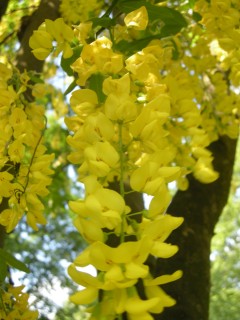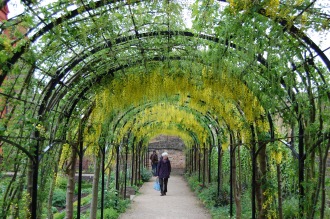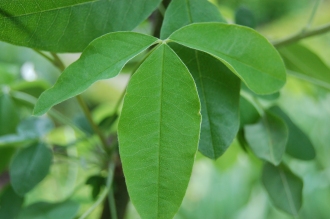Position: Full sun to partial shade
Flowering period: Late spring
Soil: Moist, well drained
Eventual Height: 7m
Eventual Spread: 7m
Hardiness: 5a, 5b, 6a, 6b, 7a, 7b, 8a, 8b, 9a
Family: Fabaceae
Subfamily: Faboideae
Laburnum anagyroides is a deciduous small tree with a spreading habit. Its mid green leaves are trifoliate, composed of elliptic to obovate leaflets which are up to 3cm long are smooth on the upper surface and hairy on the underside. Its bark is brown/ green with a bumpy texture. Its hermaphrodite yellow fragrant flowers are borne in densely packed pendulous racemes which are up to 25cm long. Its seeds are borne in flattened pods which are initially green, maturing to brown and split open to release black seeds.
Laburnum anagyroides , commonly known as Common Laburnum, Golden Rain or Golden Chain, is native to central and southern Europe. This tree has a long history of cultivation, and was introduced in to the UK in 1560. This tree readily propagates itself in the UK. All parts of this plant are poisonous, particularly the seeds. This tree will fix nitrogen in the soil.
The etymological root of the binomial name Laburnum is the ancient Lain name for this tree, possibly from origins in Lebanon. Anagyroides is derived from the Latin meaning ‘resembling the genus Anagryis‘.
The landscape architect may find Laburnum anagyroides useful as a specimen tree providing a display of bright flowers during late spring. It may be planted as an informal hedge if planted at 50cm centres and coppiced on a regular basis. Care must be taken when locating this tree as all parts are poisonous.
Ecologically, Laburnum anagyroides is attractive to bees and pollinating insects.
Laburnum anagyroides prefers moist, well-drained soils. It tolerates most pH of soil. It will tolerate nutritionally poor soil.
Laburnum anagyroides requires little maintenance. If coppicing this plant, carry out during the winter months.









Leave a comment